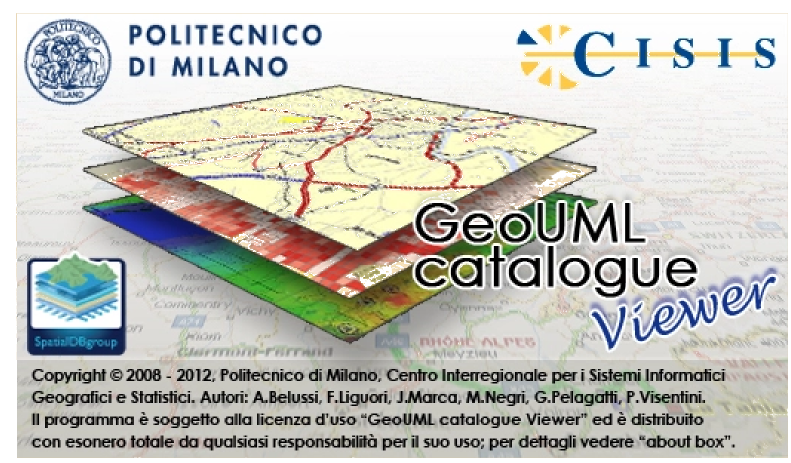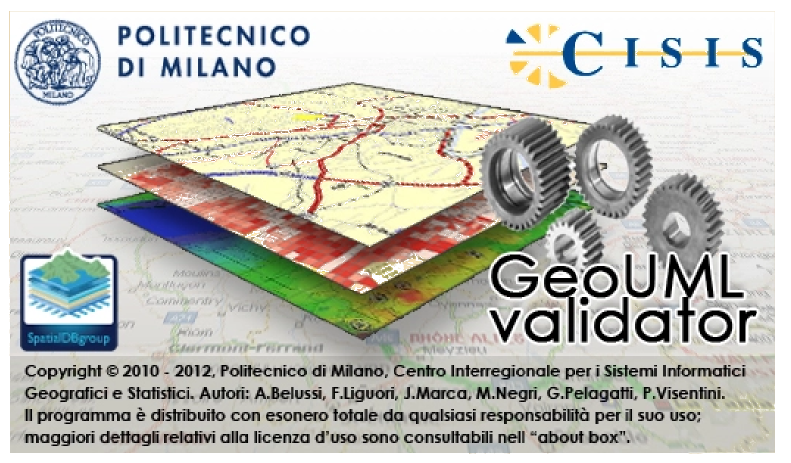The fundamental principles of this approach are:
-
- to keep a clear separation between the Conceptual Level (level of the specification) and the Physical Level of data (implementation level);

- to support many different Implementation Models that defines the mapping rules for the representation of the same Conceptual Schema on different Physical Schemas for the available mainstream technologies;
- to support the definition of many Integrity Constraints (including Spatial ones) and other structural properties at conceptual level and to allow their automatic validation on data at physical level.
- to keep a clear separation between the Conceptual Level (level of the specification) and the Physical Level of data (implementation level);
The GeoUML Methodology is supported by the GeoUML Tools; the following Tools are currently available in the download section:
- GeoUML Catalogue, which supports the definition of Conceptual Schemas (Specification) and the specification of some parameters used in the generation of physical schemas according to the chosen implementation models.

- GeoUML Validator, which performs theconformity check of a DataSet or Database with respect to a Specification (Conceptual Schema) produced by the GeoUMLCatalogue.
The development of the GeoUML Tools has been partially founded by CISIS, the coordinating authority of Italian Regions for geographical data.
The GeoUML Methodology is oriented to the creation of Spatial Data Infrastructures (SDI – see Vision), because it simplifies the implementation of DataBases that share common contents and support the definition of DataSets suitable for the exchange of those contents. In particular, the GeoUML Model and the GeoUML Catalogue have been used for the definition of the national standard “Catalogo dei Dati Territoriali – Specifiche di Contenuto per I DB Geotopografici” [“Catalogue of Geographical Data – Content Specifications for the Geo-Topographical Databases”]
(Attachments 1 and 2 to the decree “Decreto sulle regole tecniche per la definizione delle specifiche di contenuto dei database geotopografici” [“Decree on the Technical Rules for the definition of the Content Specifications for the Geo-Topographical databases”] by the Ministry for The Public Administration and for the Environment, approved and under review by the Court of Audit). Inside this standard the so-called “National Core” is defined that is the set of geo-topographical data that will have to be shared at national level.
SpatialDBGroups would aim to extend the GeoUML Methodology and the functionalities provided by the tools to support other critical areas of the SDIs creation, in particular: the harmonization of data at geometric and semantic level, the comparison of different specifications and the update of data.
VISION
In the context of the GeoUML methodology the vision of Spatial Data Infrastructure (SDI) that is considered has been widely accepted in literature; in particular it is based on the following 6 reference principles in accordance with the INSPIRE European Directive:
- Data have to be collected only once and managed where it can be done in the more efficient way.
- It should be feasible to combine data coming from different sources and to share them among several users and applications.
- It should be feasible to share information that have been collected at different levels of details.
- Spatial data that are necessary for the territory government should exist and be widely accessible.
- It should be straightforward to identify which spatial data are available, to evaluate their effectiveness for your own goals and the conditions for obtaining and using them.
- Spatial data have to be easy to understand and interpreting using visualization tools.
By considering the approaches that have been applied by different public bodies in several countries, it makes sense to classify the SDI in two categories, that are different but not unable to coexist: i) the SDI for broadcast access and ii) the highly coupled SDI.
- In the SDI for broadcast access the emphasis is on the usability of spatial data, focusing on the principles 2, 3, 5 and 6 of INSPIRE. The main tools that are adopted in this type of SDI are the Geo-Portals; their focus is on metadata and accessibility.
- In the highly coupled SDI the emphasis is on the production and management of spatial data, with the aim to obtain (principles 1 and 4 of INSPIRE) that data that are necessary for the territory government, are effectively collected and updated by the most suitable subjects and harmonized among them (principles 2 and 3 of INSPIRE). A highly coupled SDI is an infrastructure that produces and maintains, through the cooperation of a set of variable but well defined public bodies, a distributed databases, that integrates in a consistent way the spatial information that is significant and of adequate quality for achieving the goals of the bodies themselves. In this type of SDI the emphasis is on the processes of data production and update, the quality certification and the applicative cooperation.
TOOLS DOWNLOAD
GeoUML tools require a JRE SUN / Oracle version 5, 6 or 7; details on installing JRE and executing GeoUML tools are shown in the guides included in the download package. To download the tools you have to login.
Validatot-Int-Data.zip (23 downloads ) Demonstration Dataset. It contains a set of data stored in shapefiles structured using the Shape_Flat implementation model of the GeoUMLcatalogue. The dataset can be changed using your own tools and validated
GeoUMLcatalogue-viewer-Int.zip (50 downloads ) The GeoUMLcatalogue Viewer allows the browsing of a simple Conceptual Schema containing Roads and Buildings and the generation of physical schemas with different implementation models.
GeoUML-validator-Int.zip (30 downloads ) The GeoUMLvalidator is loaded with the Conceptual schema containing Roads and Buildings and allows the validation on data available in the demonstration dataset. Recall that, it needs two PostGIS databases.
DOCUMENTS
In this section you can find research and white papers regarding the GeoUML methodology and its application in real projects.
GeoUML_Methodology_and_Tools-An_Overview.pdf (222 downloads )
GeoUML-Int.pdf (234 downloads )
TRAINING
SpatialDBgroup organizes courses on request on the GeoUML tools only in Italian (english version is not available). However, documents and guides are available in the document section and in the downloaded tools zip file.
EXPERIENCES
The GeoUML Catalogue exists since the end of 2009, except for the modules regarding the generation of physical schemas different from the Oracle SQL one; the GeoUML Validator and the various implementation models (schema generator/readers) were completed at the end of 2011.
The tools are currently distributed with a free use licence and are used in several Italian regions and other public administrations in order to:
- define the local application schema starting from the National Core schema;
- define the physical structures used for the productions of new data (gml and shape file formats);
- design the PostGIS and Oracle spatial databases;
- validate the conformance of spatial dataset (production datasets or database) to the structural and spatial constraints defined in the application schema.
CONTRIBUTIONS IN NATIONAL AND REGIONAL TECHNICAL STANDARDS (in italian)
G.Pelagatti , “Il modello concettuale GeoUML. Inquadramento generale ed introduzione all’uso”, 1n1010_2, v.2.1, 7/4/2004.
A.Belussi, M.Negri, G.Pelagatti, “Il modello concettuale GeoUML: Specifica formale in UML”, IntesaGIS doc. n. 1n1010_1, v.2.1, 7/4/2004, approved by Comitato Tecnico Nazionale per il coordinamento informatico dei dati territoriali, published by CNIPA (Italian National Authority for Informatics in the Public Administration), now AGID (Agenzia per l’Italia digitale) www.agid.gov.it 2007.
F.Liguori Il catalogo degli oggetti (revisione delle specifiche di contenuto 1n1007_1 e 1n1007_2), v.3.3, 25/4/2006.
A.Belussi, F.Liguori, M.Negri, G.Pelagatti, “Specifiche di contenuto: Lo schema del contenuto in GeoUML”, (revision of the document intesaGIS n.1n1007_4, 2004), v.3.3, 25/4/2006 approved by Comitato Tecnico Nazionale per il coordinamento informatico dei dati territoriali, published by CNIPA www.agid.gov.it 2007.
M.Negri, G.Pelagatti, “Linee guida per la costruzione del Sistema Informativo Integrato del Sottosuolo (SIIS)”, BOLLETTINO UFFICIALE DELLA REGIONE LOMBARDIA, 23 bis, pp. 1-101, 2008,
F.Guzzetti, F.Liguori, M.Negri, C.Dell’orto, “Specifiche tecniche aerofotogrammetriche per la realizzazione del Database topografico alle scale 1:1000 e 1:2000 – Specifiche tecniche aerofotogrammetriche per la realizzazione del Database topografico alle scale 1:5000 e 1:10000 – Specifiche di contenuto e schema fisico di consegna del database topografico – Specifiche tecniche per l’aggiornamento di cartografie numeriche ed il loro adeguamento al database topografico”, BOLLETTINO UFFICIALE DELLA REGIONE LOMBARDIA, 1° supplemento, pp. 1- 200, 2008.
A.Belussi, M.Negri, G.Pelagatti, “Il modello GeoUML – Regole di interpretazione delle specifiche di contenuto per i DataBase Geotopografici”, Allegato 2 al DECRETO DELLA PRESIDENZA DEL CONSIGLIO DEI MINISTRI, Regole tecniche per la definizione delle specifiche di contenuto dei database geotopografici 10 novembre 2011. Gazzetta Ufficiale n. 48 del 27/02/2012 – Supplemento ordinario n. 37, disponibile http://geodati.gov.it/geoportale/datiterritoriali/regole-tecniche file Decreto_10/11/2011 – Specifiche di contenuto – allegato 2 (pdf)
RESEARCH PAPERS
A.BELUSSI, S.MIGLIORINI,M.NEGRI (2020), “A framework for evaluating 3D topological relations based on a vector data model”, Geoinformatica, ISSN 1384-6175, Kluwer Academic Publishers, vol. 24 , issue 4, pp. 915-950, 2020
A.BELUSSI, S.MIGLIORINI,M.NEGRI,G.PELAGATTI (2020), “A template-based approach for the specification of 3D topological constraints”, Geoinformatica, ISSN 1384-6175, Kluwer Academic Publishers, vol. 24 , issue 3, pp. 683-712, 2020
A.BELUSSI, S.CARRA, S.MIGLIORINI, M.NEGRI (2019), “Efficient MapReduce computation of topological relations for big geometries”, Proc. 8th ACM SIGSPATIAL International Workshop on Analytics for Big Geospatial Data (BigSpatial ’19), pp.1-8, Chicago, Illinois (USA)
A.BELUSSI, S.CARRA, S.MIGLIORINI, M.NEGRI, G.PELAGATTI (2018), “What Makes Spatial Data Big? A Discussion on How to Partition Spatial Data”, Proc. 10th International Conference on Geographic Information Science (GIScience 2018), LEIBNIZ INTERNATIONAL PROCEEDINGS IN INFORMATICS series, Vol. 114, pp.1-15, Melbourne, Australia.
A.BELUSSI, S.MIGLIORINI, M.NEGRI, G.PELAGATTI (2017), “Establishing Robustness of a Spatial Dataset in a Tolerance-Based Vector Model”, Transactions in GIS, John Wiley & sons, vol.21, n.4, pp.722-747
A.BELUSSI, S.MIGLIORINI, M.NEGRI, G.PELAGATTI, (2016) “Towards massive spatial data validation with SpatialHadoop”, Proc. 5th ACM SIGSPATIAL International Workshop on Analytics for Big Geospatial Data (BigSpatial ’16), Burlingame, California, USA.
A.BELUSSI, S.MIGLIORINI, M.NEGRI, G.PELAGATTI (2016), “Snap Rounding with Restore: an Algorithm for Producing Robust Geometric Datasets”, ACM Transactions on spatial algorithms and systems, vol.2, n.1, pp. 1-36
A.BELUSSI, S.MIGLIORINI, M.NEGRI, G.PELAGATTI (2015), “Validation of spatial integrity constraints in city models”, Proc. 4th ACM SIGSPATIAL International Workshop on Mobile Geographic Information Systems, pp. 70-79, Seattle, Washington, USA
A.BELUSSI, S.MIGLIORINI, M. NEGRI, G. PELAGATTI (2015) “Impact of Data Representation Rules on the Robustness of Topological Relation Evaluation”, Geoinformatica, Kluwer Academic Publishers, vol. 19, n. 2, pp. 185-226
A.BELUSSI, M.NEGRI, G.PELAGATTI (2014), IDMB: a Tool for Navigating the INSPIRE Data Model and Generating an INSPIRE SQL Database and WFS Configuration, “INSPIRE Conference”, Aalborg, Danimarca
A.BELUSSI, P.CIPRIANO, S.MIGLIORINI, M.NEGRI, G.PELAGATTI (2014), Design of the Data Transformation Architecture for the INSPIRE Data Model Browser, in Connecting a Digital Europe through Location and Place , “AGILE’2014 International Conference on Geographic Information Science” , Castellón, Spain
A.BELUSSI, S. MIGLIORINI, M.NEGRI, G.PELAGATTI (2013), On robust interpretation of topological relations in identity and tolerance models. 21st ACM SIGSPATIAL International Conference on Advances in Geographic Information Systems (ACM SIGSPATIAL GIS 2013), Orlando, Florida, USA
J.MARCA, M.NEGRI, G.PELAGATTI (2013) , Application of the GeoUML tools for the production and validation of Inspire datasets, INSPIRE 2013 conference: the green renaissance, Florence, Italy
A.BELUSSI, S.MIGLIORINI, M.NEGRI, G.PELAGATTI (2012), Robustness of Spatial Relation Evaluation in Data Exchange, 20th ACM SIGSPATIAL International Conference on Advances in GIS, Redondo Beach, California, USA
A. BELUSSI, F. LIGUORI, J. MARCA, S. MIGLIORINI, M. NEGRI, G. PELAGATTI, P. VISENTINI (2011), Validation of Geographical Datasets against Spatial Constraints at Conceptual Level, “The Urban Data Management Symposium (UDMS 2011)”, Delft, The Netherlands
S. MIGLIORINI, M. GAMBINI, A. BELUSSI, M. NEGRI, G. PELAGATTI (2011), Workflow Technology for Geo-Processing: The Missing Link, “2nd International Conference on Computing for Geospacial Research & Application (COM.Geo ’11)”, Washington, DC, USA
A. BELUSSI, S. MIGLIORINI, M. NEGRI, G. PELAGATTI (2010), Managing Collapsed Surfaces in Spatial Constraints Validation, in Geospatial Thinking edited by di M. Painho, M.Y. Santos and H. Pundt, Springer, “The 13th AGILE International Conference on Geographic Information Science”, Guimarães, Portugal, pp. 259-278.
A. BELUSSI, S. MIGLIORINI, M. NEGRI, G. PELAGATTI (2009) From the Conceptual Design of Spatial Constraints to their Implementation in Real Systems, “17th ACM SIGSPATIAL International Conference on Advances in GIS”, Seattle, Washington, USA, pp. 448-451.
A. BELUSSI, F. LIGUORI, J. MARCA, S. MIGLIORINI, M. NEGRI, G. PELAGATTI, P. VISENTINI (2009) Transferring Segmented Properties in the Conflation of Transportation Networks, in Advances in GIScience edited by M.Sester, L.Bernard and V.Paelke ,Springer, “AGILE 2009” conference, Hannover, Germany, pp.195-215.
A. BELUSSI, F. LIGUORI, J. MARCA, M. NEGRI, G. PELAGATTI (2008) Ownership definition and instances integration in highly coupled Spatial Data Infrastructures, in Lecture Notes in Geoinformation and Cartography edited by Lars Bernard et. al., Berlin – Heidelberg, Springer, “AGILE conference 2008”, Girona, Spain, pp. 379-399.
A. BELUSSI, M. NEGRI, G. PELAGATTI (2006) An ISO TC 211 Conformant Approach to Model Spatial Integrity Constraints in the Conceptual Design of Geographical Databases, in Lecture Notes in Computer Science edited by John F. Roddick et al., Berlin/Heidelberg, Springer, “ER 2006 (CoMoGIS workshop)”, Tucson, AZ, USA, pp. 100-109.
A. BELUSSI, M.A. BROVELLI, M. NEGRI, G. PELAGATTI, F. SANSÒ (2006) Dealing with Multiple Accuracy Levels in Spatial Databases with Continuous Update, “The Seventh International Symposium on Spatial Accuracy Assessment in Natural Resources and Environmental Sciences (Spatial Accuracy 2006)”, Lisbon, Portugal, pp. 203-212.
A. BELUSSI, M. NEGRI, G. PELAGATTI (2006) Modelling Spatial Whole-Part Relationships using an ISO-TC211 conformant approach, «Information and Software Technology», vol.48, pp.1095-1103.
